Report: Impact of Healthcare Policies on Different Age Groups - [Year]
VerifiedAdded on 2019/10/08
|7
|1525
|265
Report
AI Summary
This report examines the impact of healthcare policies, specifically the Affordable Care Act (ACA) of 2010, on various segments of the US population. It focuses on the negative impacts on young adults aged 22-35, who are often forced to participate in healthcare plans and bear financial burdens, including increased costs and taxes. The report analyzes how the ACA has affected healthcare costs, insurance coverage, and the overall healthcare system, including wait times and workforce stress. It also compares the current status of healthcare policies, including the ongoing debates around the ACA, to the past, highlighting enrollment figures, subsidies, and the efforts to improve healthcare access and affordability. The report references various sources to support its findings and provides a comprehensive overview of the complexities and effects of healthcare reform in the United States.
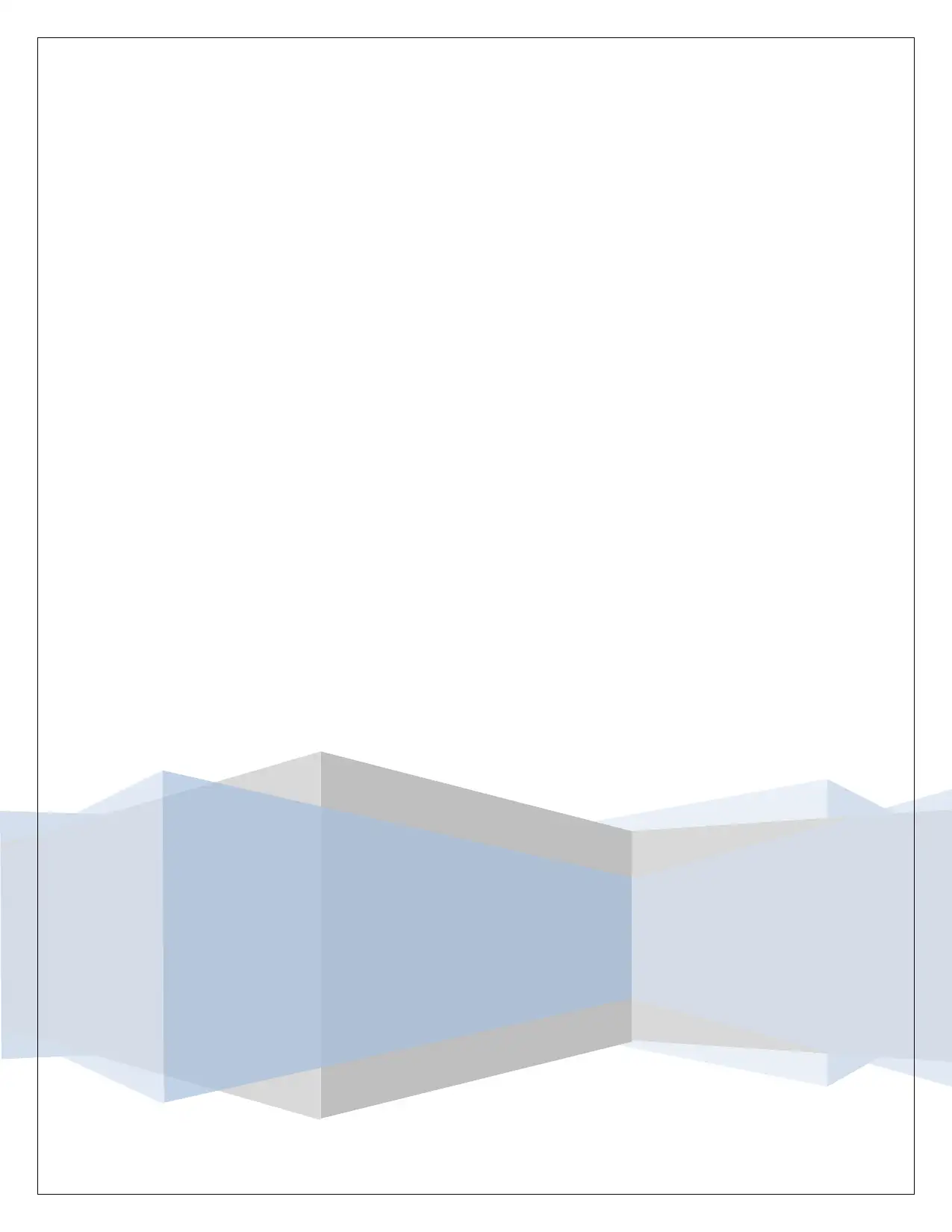
Paraphrase This Document
Need a fresh take? Get an instant paraphrase of this document with our AI Paraphraser
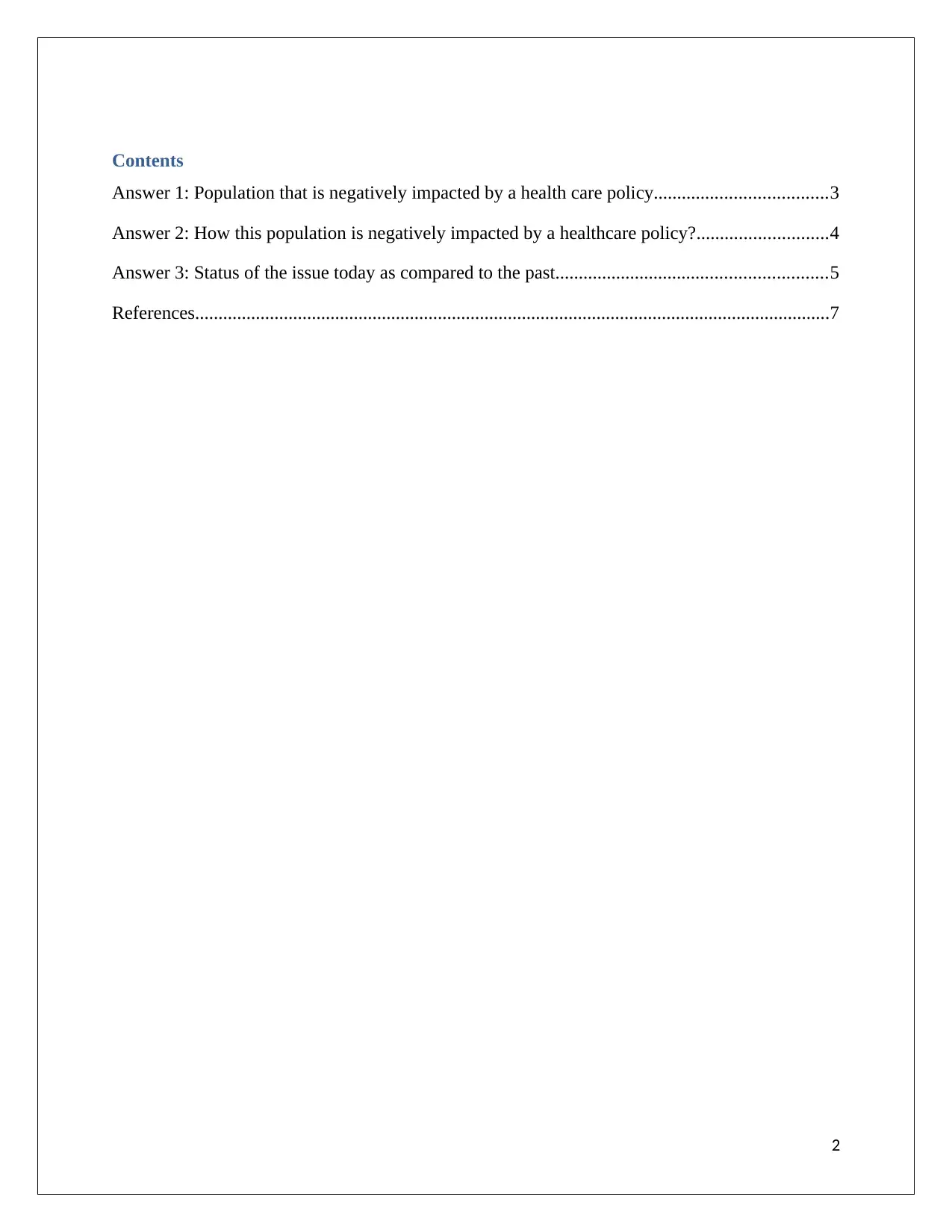
Contents
Answer 1: Population that is negatively impacted by a health care policy.....................................3
Answer 2: How this population is negatively impacted by a healthcare policy?............................4
Answer 3: Status of the issue today as compared to the past..........................................................5
References........................................................................................................................................7
2
Answer 1: Population that is negatively impacted by a health care policy.....................................3
Answer 2: How this population is negatively impacted by a healthcare policy?............................4
Answer 3: Status of the issue today as compared to the past..........................................................5
References........................................................................................................................................7
2
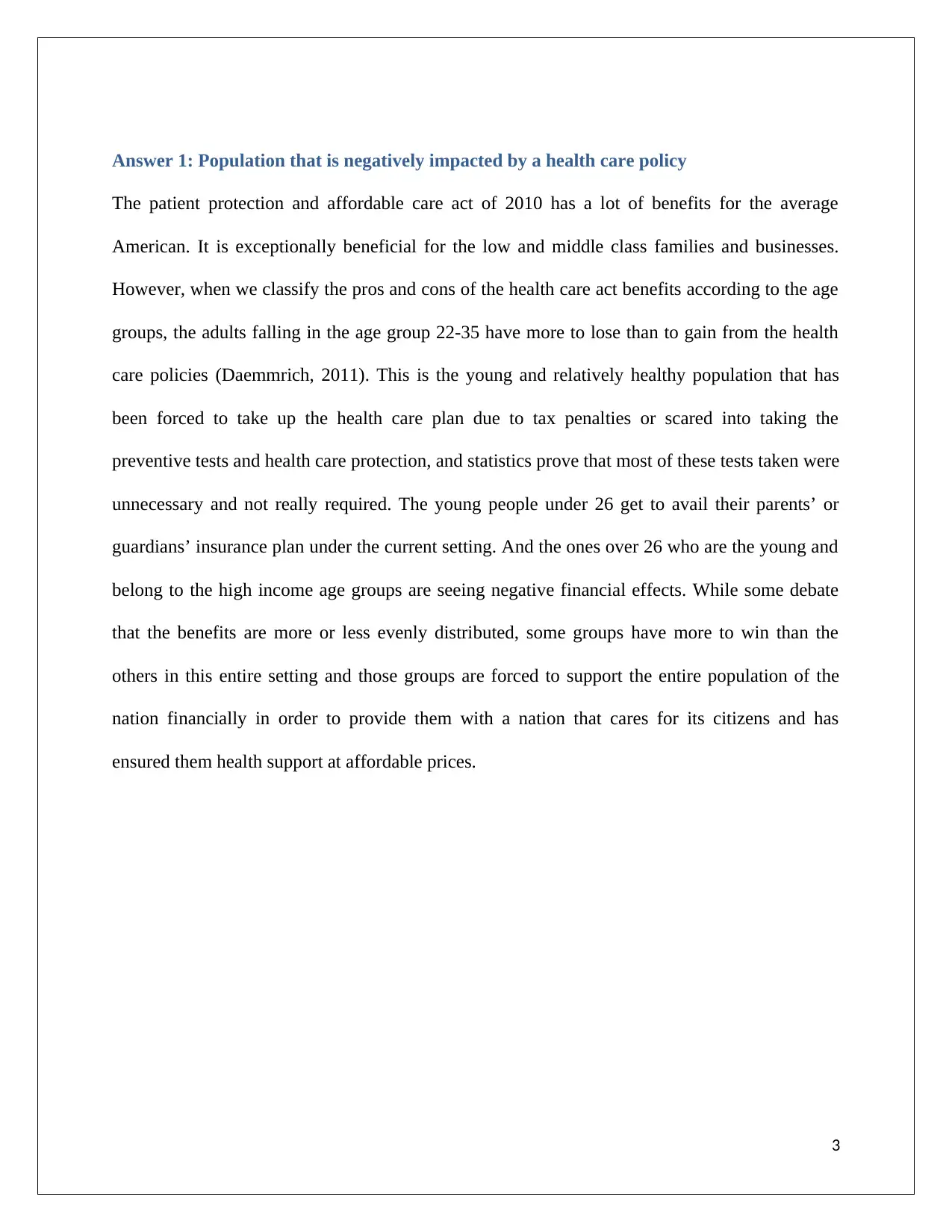
Answer 1: Population that is negatively impacted by a health care policy
The patient protection and affordable care act of 2010 has a lot of benefits for the average
American. It is exceptionally beneficial for the low and middle class families and businesses.
However, when we classify the pros and cons of the health care act benefits according to the age
groups, the adults falling in the age group 22-35 have more to lose than to gain from the health
care policies (Daemmrich, 2011). This is the young and relatively healthy population that has
been forced to take up the health care plan due to tax penalties or scared into taking the
preventive tests and health care protection, and statistics prove that most of these tests taken were
unnecessary and not really required. The young people under 26 get to avail their parents’ or
guardians’ insurance plan under the current setting. And the ones over 26 who are the young and
belong to the high income age groups are seeing negative financial effects. While some debate
that the benefits are more or less evenly distributed, some groups have more to win than the
others in this entire setting and those groups are forced to support the entire population of the
nation financially in order to provide them with a nation that cares for its citizens and has
ensured them health support at affordable prices.
3
The patient protection and affordable care act of 2010 has a lot of benefits for the average
American. It is exceptionally beneficial for the low and middle class families and businesses.
However, when we classify the pros and cons of the health care act benefits according to the age
groups, the adults falling in the age group 22-35 have more to lose than to gain from the health
care policies (Daemmrich, 2011). This is the young and relatively healthy population that has
been forced to take up the health care plan due to tax penalties or scared into taking the
preventive tests and health care protection, and statistics prove that most of these tests taken were
unnecessary and not really required. The young people under 26 get to avail their parents’ or
guardians’ insurance plan under the current setting. And the ones over 26 who are the young and
belong to the high income age groups are seeing negative financial effects. While some debate
that the benefits are more or less evenly distributed, some groups have more to win than the
others in this entire setting and those groups are forced to support the entire population of the
nation financially in order to provide them with a nation that cares for its citizens and has
ensured them health support at affordable prices.
3
⊘ This is a preview!⊘
Do you want full access?
Subscribe today to unlock all pages.

Trusted by 1+ million students worldwide
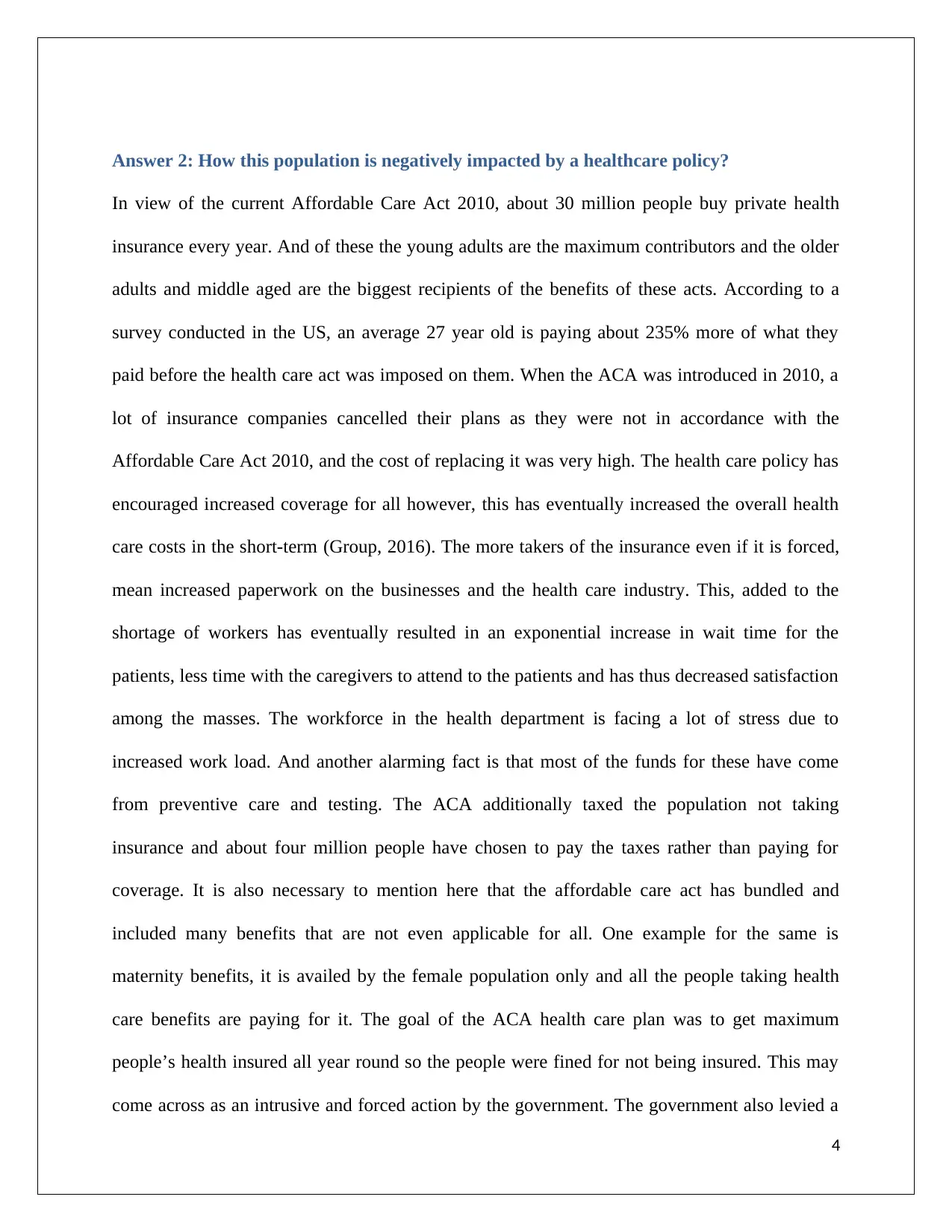
Answer 2: How this population is negatively impacted by a healthcare policy?
In view of the current Affordable Care Act 2010, about 30 million people buy private health
insurance every year. And of these the young adults are the maximum contributors and the older
adults and middle aged are the biggest recipients of the benefits of these acts. According to a
survey conducted in the US, an average 27 year old is paying about 235% more of what they
paid before the health care act was imposed on them. When the ACA was introduced in 2010, a
lot of insurance companies cancelled their plans as they were not in accordance with the
Affordable Care Act 2010, and the cost of replacing it was very high. The health care policy has
encouraged increased coverage for all however, this has eventually increased the overall health
care costs in the short-term (Group, 2016). The more takers of the insurance even if it is forced,
mean increased paperwork on the businesses and the health care industry. This, added to the
shortage of workers has eventually resulted in an exponential increase in wait time for the
patients, less time with the caregivers to attend to the patients and has thus decreased satisfaction
among the masses. The workforce in the health department is facing a lot of stress due to
increased work load. And another alarming fact is that most of the funds for these have come
from preventive care and testing. The ACA additionally taxed the population not taking
insurance and about four million people have chosen to pay the taxes rather than paying for
coverage. It is also necessary to mention here that the affordable care act has bundled and
included many benefits that are not even applicable for all. One example for the same is
maternity benefits, it is availed by the female population only and all the people taking health
care benefits are paying for it. The goal of the ACA health care plan was to get maximum
people’s health insured all year round so the people were fined for not being insured. This may
come across as an intrusive and forced action by the government. The government also levied a
4
In view of the current Affordable Care Act 2010, about 30 million people buy private health
insurance every year. And of these the young adults are the maximum contributors and the older
adults and middle aged are the biggest recipients of the benefits of these acts. According to a
survey conducted in the US, an average 27 year old is paying about 235% more of what they
paid before the health care act was imposed on them. When the ACA was introduced in 2010, a
lot of insurance companies cancelled their plans as they were not in accordance with the
Affordable Care Act 2010, and the cost of replacing it was very high. The health care policy has
encouraged increased coverage for all however, this has eventually increased the overall health
care costs in the short-term (Group, 2016). The more takers of the insurance even if it is forced,
mean increased paperwork on the businesses and the health care industry. This, added to the
shortage of workers has eventually resulted in an exponential increase in wait time for the
patients, less time with the caregivers to attend to the patients and has thus decreased satisfaction
among the masses. The workforce in the health department is facing a lot of stress due to
increased work load. And another alarming fact is that most of the funds for these have come
from preventive care and testing. The ACA additionally taxed the population not taking
insurance and about four million people have chosen to pay the taxes rather than paying for
coverage. It is also necessary to mention here that the affordable care act has bundled and
included many benefits that are not even applicable for all. One example for the same is
maternity benefits, it is availed by the female population only and all the people taking health
care benefits are paying for it. The goal of the ACA health care plan was to get maximum
people’s health insured all year round so the people were fined for not being insured. This may
come across as an intrusive and forced action by the government. The government also levied a
4
Paraphrase This Document
Need a fresh take? Get an instant paraphrase of this document with our AI Paraphraser
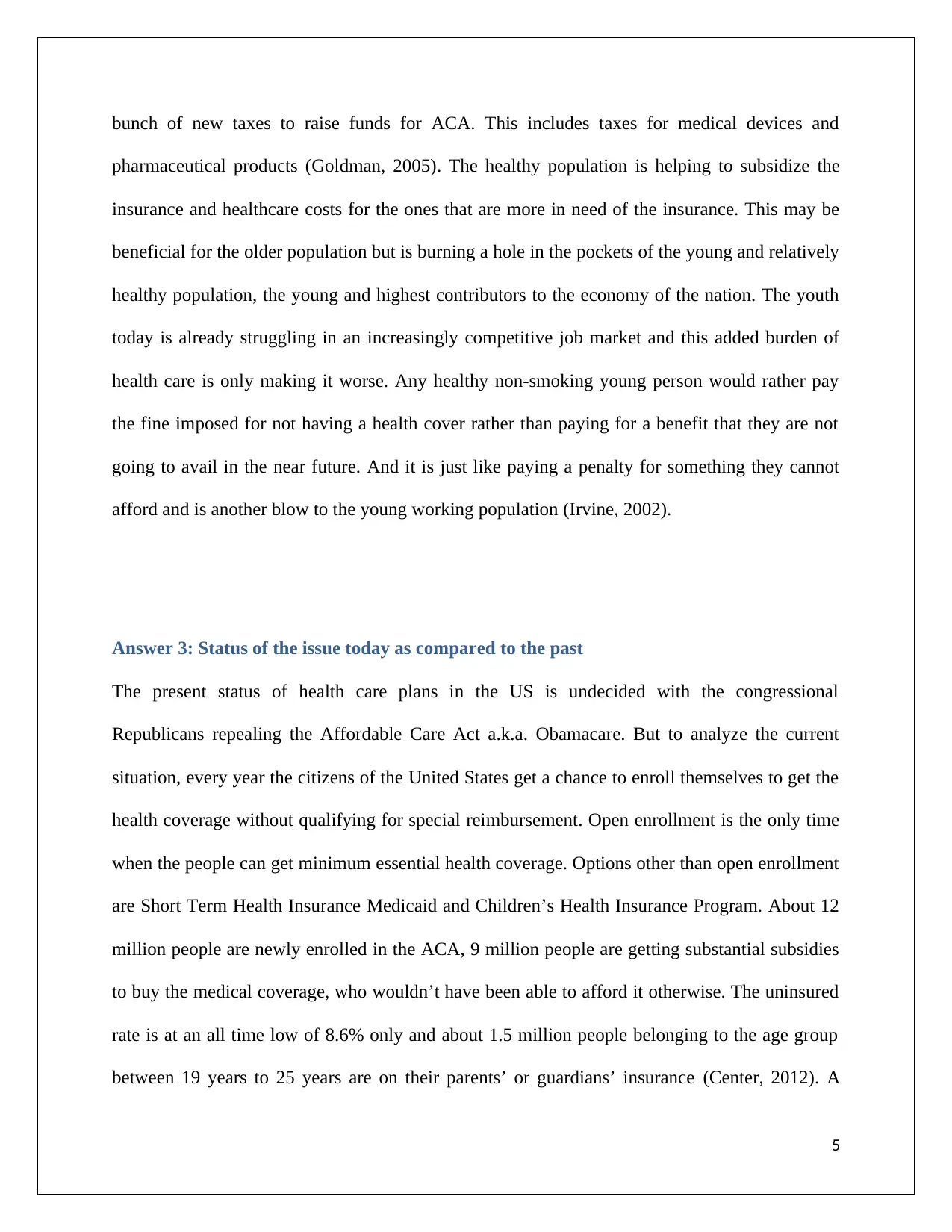
bunch of new taxes to raise funds for ACA. This includes taxes for medical devices and
pharmaceutical products (Goldman, 2005). The healthy population is helping to subsidize the
insurance and healthcare costs for the ones that are more in need of the insurance. This may be
beneficial for the older population but is burning a hole in the pockets of the young and relatively
healthy population, the young and highest contributors to the economy of the nation. The youth
today is already struggling in an increasingly competitive job market and this added burden of
health care is only making it worse. Any healthy non-smoking young person would rather pay
the fine imposed for not having a health cover rather than paying for a benefit that they are not
going to avail in the near future. And it is just like paying a penalty for something they cannot
afford and is another blow to the young working population (Irvine, 2002).
Answer 3: Status of the issue today as compared to the past
The present status of health care plans in the US is undecided with the congressional
Republicans repealing the Affordable Care Act a.k.a. Obamacare. But to analyze the current
situation, every year the citizens of the United States get a chance to enroll themselves to get the
health coverage without qualifying for special reimbursement. Open enrollment is the only time
when the people can get minimum essential health coverage. Options other than open enrollment
are Short Term Health Insurance Medicaid and Children’s Health Insurance Program. About 12
million people are newly enrolled in the ACA, 9 million people are getting substantial subsidies
to buy the medical coverage, who wouldn’t have been able to afford it otherwise. The uninsured
rate is at an all time low of 8.6% only and about 1.5 million people belonging to the age group
between 19 years to 25 years are on their parents’ or guardians’ insurance (Center, 2012). A
5
pharmaceutical products (Goldman, 2005). The healthy population is helping to subsidize the
insurance and healthcare costs for the ones that are more in need of the insurance. This may be
beneficial for the older population but is burning a hole in the pockets of the young and relatively
healthy population, the young and highest contributors to the economy of the nation. The youth
today is already struggling in an increasingly competitive job market and this added burden of
health care is only making it worse. Any healthy non-smoking young person would rather pay
the fine imposed for not having a health cover rather than paying for a benefit that they are not
going to avail in the near future. And it is just like paying a penalty for something they cannot
afford and is another blow to the young working population (Irvine, 2002).
Answer 3: Status of the issue today as compared to the past
The present status of health care plans in the US is undecided with the congressional
Republicans repealing the Affordable Care Act a.k.a. Obamacare. But to analyze the current
situation, every year the citizens of the United States get a chance to enroll themselves to get the
health coverage without qualifying for special reimbursement. Open enrollment is the only time
when the people can get minimum essential health coverage. Options other than open enrollment
are Short Term Health Insurance Medicaid and Children’s Health Insurance Program. About 12
million people are newly enrolled in the ACA, 9 million people are getting substantial subsidies
to buy the medical coverage, who wouldn’t have been able to afford it otherwise. The uninsured
rate is at an all time low of 8.6% only and about 1.5 million people belonging to the age group
between 19 years to 25 years are on their parents’ or guardians’ insurance (Center, 2012). A
5
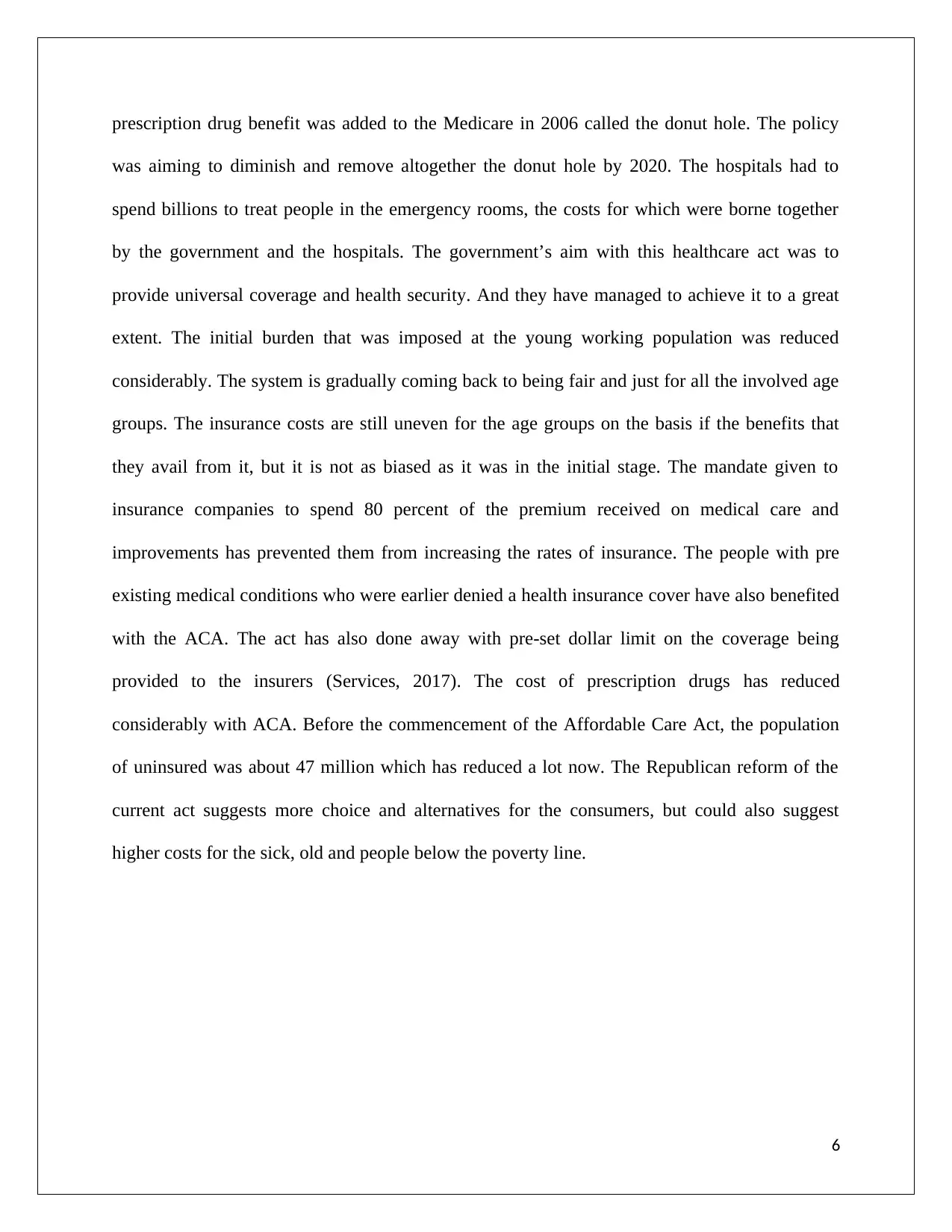
prescription drug benefit was added to the Medicare in 2006 called the donut hole. The policy
was aiming to diminish and remove altogether the donut hole by 2020. The hospitals had to
spend billions to treat people in the emergency rooms, the costs for which were borne together
by the government and the hospitals. The government’s aim with this healthcare act was to
provide universal coverage and health security. And they have managed to achieve it to a great
extent. The initial burden that was imposed at the young working population was reduced
considerably. The system is gradually coming back to being fair and just for all the involved age
groups. The insurance costs are still uneven for the age groups on the basis if the benefits that
they avail from it, but it is not as biased as it was in the initial stage. The mandate given to
insurance companies to spend 80 percent of the premium received on medical care and
improvements has prevented them from increasing the rates of insurance. The people with pre
existing medical conditions who were earlier denied a health insurance cover have also benefited
with the ACA. The act has also done away with pre-set dollar limit on the coverage being
provided to the insurers (Services, 2017). The cost of prescription drugs has reduced
considerably with ACA. Before the commencement of the Affordable Care Act, the population
of uninsured was about 47 million which has reduced a lot now. The Republican reform of the
current act suggests more choice and alternatives for the consumers, but could also suggest
higher costs for the sick, old and people below the poverty line.
6
was aiming to diminish and remove altogether the donut hole by 2020. The hospitals had to
spend billions to treat people in the emergency rooms, the costs for which were borne together
by the government and the hospitals. The government’s aim with this healthcare act was to
provide universal coverage and health security. And they have managed to achieve it to a great
extent. The initial burden that was imposed at the young working population was reduced
considerably. The system is gradually coming back to being fair and just for all the involved age
groups. The insurance costs are still uneven for the age groups on the basis if the benefits that
they avail from it, but it is not as biased as it was in the initial stage. The mandate given to
insurance companies to spend 80 percent of the premium received on medical care and
improvements has prevented them from increasing the rates of insurance. The people with pre
existing medical conditions who were earlier denied a health insurance cover have also benefited
with the ACA. The act has also done away with pre-set dollar limit on the coverage being
provided to the insurers (Services, 2017). The cost of prescription drugs has reduced
considerably with ACA. Before the commencement of the Affordable Care Act, the population
of uninsured was about 47 million which has reduced a lot now. The Republican reform of the
current act suggests more choice and alternatives for the consumers, but could also suggest
higher costs for the sick, old and people below the poverty line.
6
⊘ This is a preview!⊘
Do you want full access?
Subscribe today to unlock all pages.

Trusted by 1+ million students worldwide
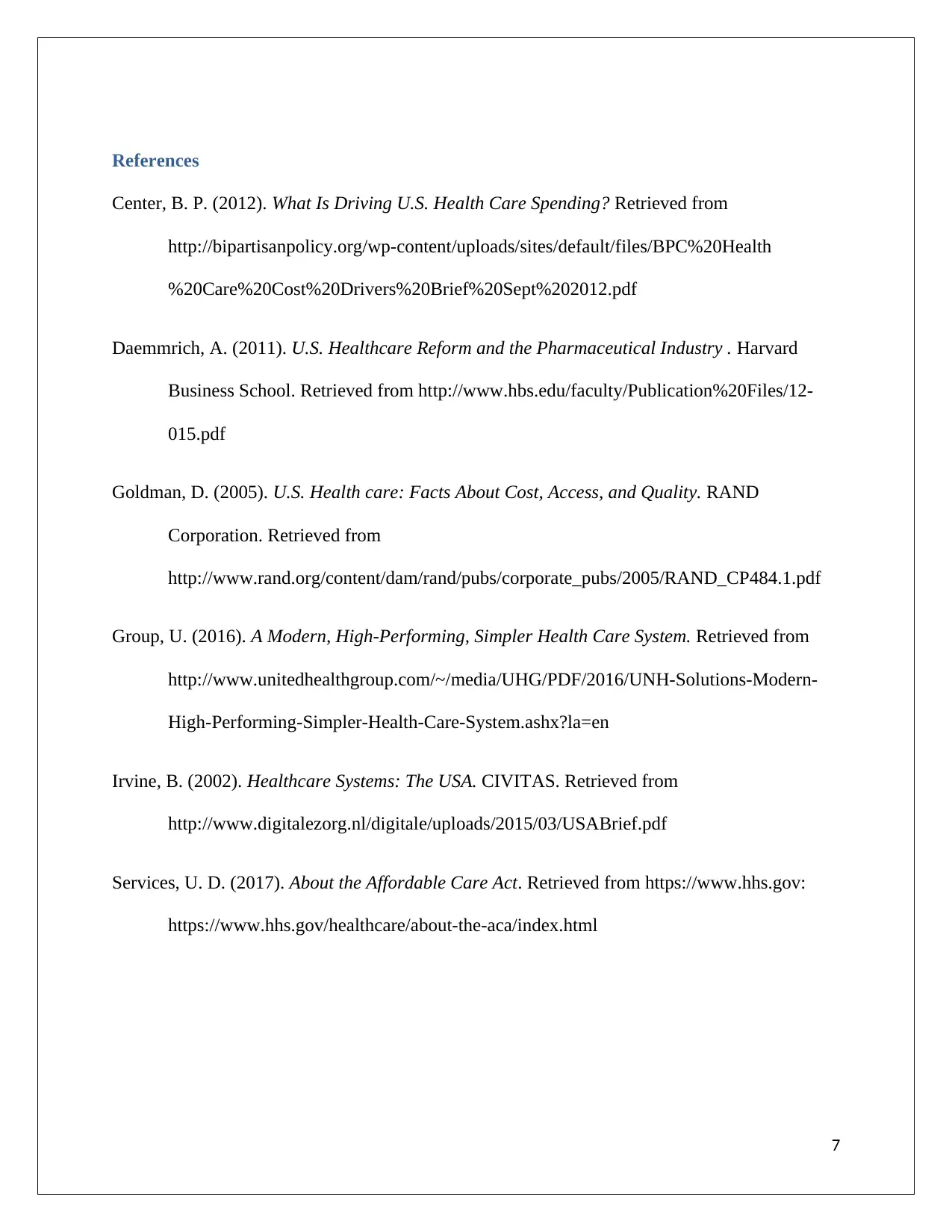
References
Center, B. P. (2012). What Is Driving U.S. Health Care Spending? Retrieved from
http://bipartisanpolicy.org/wp-content/uploads/sites/default/files/BPC%20Health
%20Care%20Cost%20Drivers%20Brief%20Sept%202012.pdf
Daemmrich, A. (2011). U.S. Healthcare Reform and the Pharmaceutical Industry . Harvard
Business School. Retrieved from http://www.hbs.edu/faculty/Publication%20Files/12-
015.pdf
Goldman, D. (2005). U.S. Health care: Facts About Cost, Access, and Quality. RAND
Corporation. Retrieved from
http://www.rand.org/content/dam/rand/pubs/corporate_pubs/2005/RAND_CP484.1.pdf
Group, U. (2016). A Modern, High-Performing, Simpler Health Care System. Retrieved from
http://www.unitedhealthgroup.com/~/media/UHG/PDF/2016/UNH-Solutions-Modern-
High-Performing-Simpler-Health-Care-System.ashx?la=en
Irvine, B. (2002). Healthcare Systems: The USA. CIVITAS. Retrieved from
http://www.digitalezorg.nl/digitale/uploads/2015/03/USABrief.pdf
Services, U. D. (2017). About the Affordable Care Act. Retrieved from https://www.hhs.gov:
https://www.hhs.gov/healthcare/about-the-aca/index.html
7
Center, B. P. (2012). What Is Driving U.S. Health Care Spending? Retrieved from
http://bipartisanpolicy.org/wp-content/uploads/sites/default/files/BPC%20Health
%20Care%20Cost%20Drivers%20Brief%20Sept%202012.pdf
Daemmrich, A. (2011). U.S. Healthcare Reform and the Pharmaceutical Industry . Harvard
Business School. Retrieved from http://www.hbs.edu/faculty/Publication%20Files/12-
015.pdf
Goldman, D. (2005). U.S. Health care: Facts About Cost, Access, and Quality. RAND
Corporation. Retrieved from
http://www.rand.org/content/dam/rand/pubs/corporate_pubs/2005/RAND_CP484.1.pdf
Group, U. (2016). A Modern, High-Performing, Simpler Health Care System. Retrieved from
http://www.unitedhealthgroup.com/~/media/UHG/PDF/2016/UNH-Solutions-Modern-
High-Performing-Simpler-Health-Care-System.ashx?la=en
Irvine, B. (2002). Healthcare Systems: The USA. CIVITAS. Retrieved from
http://www.digitalezorg.nl/digitale/uploads/2015/03/USABrief.pdf
Services, U. D. (2017). About the Affordable Care Act. Retrieved from https://www.hhs.gov:
https://www.hhs.gov/healthcare/about-the-aca/index.html
7
1 out of 7
Related Documents
Your All-in-One AI-Powered Toolkit for Academic Success.
+13062052269
info@desklib.com
Available 24*7 on WhatsApp / Email
![[object Object]](/_next/static/media/star-bottom.7253800d.svg)
Unlock your academic potential
Copyright © 2020–2025 A2Z Services. All Rights Reserved. Developed and managed by ZUCOL.




